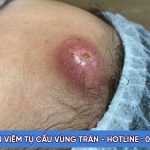TREATING HUGE STABICOCCAL ACNE – AT HHV CLINIC | Do Thu Hien |
Please scroll down to watch the video.👇👇
Treating huge Staphylococcal (Staph) acne—which is often inflamed, painful, pus-filled, and stubborn—requires immediate and targeted treatment. This type of acne is usually caused by an overgrowth of Staphylococcus aureus, and it behaves more like a bacterial skin infection than typical hormonal or comedonal acne.
Here’s a detailed, medically-backed approach:
🦠 1. Medical Diagnosis First (VERY Important)
Before starting treatment:
-
Get a skin culture from a dermatologist to confirm Staph aureus.
-
This rules out MRSA (methicillin-resistant staph), which needs stronger medication.
Why it matters: Staph acne can look like cystic acne but needs a different treatment plan.
💊 2. Prescription Antibiotics (Oral + Topical)
If confirmed:
▶️ Oral antibiotics (7–14 days typical course):
-
First-line:
-
Dicloxacillin or Cephalexin (if not MRSA)
-
Doxycycline or Trimethoprim-sulfamethoxazole (Bactrim) if resistant strain (e.g. MRSA)
-
-
Important: Always take the full course to prevent relapse and resistance.
▶️ Topical antibiotics:
-
Mupirocin (Bactroban): Applied to infected areas and inside the nose (common staph colonization site).
-
Chlorhexidine wash: Daily antiseptic skin wash to reduce bacterial load.
💉 3. Drainage for Huge Lesions
If any abscess-like lesions form:
-
A dermatologist may drain them (called I&D – incision and drainage).
-
Do NOT squeeze them yourself — it can worsen the infection or spread bacteria.
💧 4. Daily Skin Hygiene & Lifestyle
-
Use antibacterial soap or benzoyl peroxide cleanser (5–10%) daily.
-
Avoid sharing towels, razors, or makeup.
-
Change pillowcases, towels, and clothes daily while infected.
-
Keep hands away from the face.
🔄 5. Eradicating Nasal Carriage (if recurrent)
-
Some people carry staph in their nostrils—a major cause of reinfection.
-
Doctors may prescribe:
-
Nasal mupirocin twice daily for 5 days
-
Bleach baths (diluted) a few times a week (1/2 cup bleach in full tub of water for 10 min)
-
🧴 6. After Recovery: Preventing Scars
Once infection clears:
-
Use azelaic acid or niacinamide to fade any dark spots.
-
For pits or scars, consider microneedling or laser after full healing (not during active infection).
🚨 When to Seek Immediate Help:
-
If the acne is rapidly spreading
-
Fever or swollen lymph nodes appear
-
Boils form repeatedly despite treatment
-
Suspected MRSA
✅ Summary:
| Treatment Step | What to Use | Why It Helps |
|---|---|---|
| Confirm diagnosis | Skin culture | Rule out MRSA |
| Oral antibiotics | Doxycycline, Bactrim, Cephalexin | Kill systemic infection |
| Topical antibiotics | Mupirocin, chlorhexidine | Kill surface and nasal staph |
| Skin hygiene | Benzoyl peroxide, bleach baths | Reduce skin bacteria |
| Specialist treatment | I&D, nasal decolonization | Prevent spreading or relapse |
Treating severe Staphylococcal (Staphylococcus aureus) skin infections, often mistaken for “huge staph acne,” requires a comprehensive approach. These infections can resemble acne but are typically more painful, swollen, and may not respond to standard acne treatments. Here’s an evidence-based guide to managing such infections:Healthline
🔬 Understanding Staphylococcal Skin Infections
Staphylococcus aureus is a bacterium commonly found on the skin and in the nasal passages. While often harmless, it can cause infections when it enters the skin through cuts or abrasions. These infections can manifest as boils, abscesses, or cellulitis and may resemble severe acne lesions. Some strains, like Methicillin-resistant Staphylococcus aureus (MRSA), are resistant to certain antibiotics, complicating treatment. Verywell Health
🩺 Diagnosis and Initial Assessment
-
Clinical Evaluation: A healthcare provider will assess the lesions’ appearance, distribution, and associated symptoms.
-
Laboratory Tests: In cases where MRSA is suspected or if the infection is recurrent, a culture and sensitivity test may be performed to identify the specific bacteria and determine the most effective antibiotics.
💊 Treatment Strategies
1. Antibiotic Therapy
-
Topical Antibiotics: For minor skin infections, topical antibiotics like mupirocin 2% ointment can be effective. Academic Oxford
-
Oral Antibiotics: Moderate to severe infections may require oral antibiotics. The choice depends on the bacteria’s sensitivity:
-
Methicillin-sensitive Staphylococcus aureus (MSSA): Antibiotics such as dicloxacillin or cephalexin are commonly used. Mayo Clinic
-
MRSA: Options include trimethoprim-sulfamethoxazole (Bactrim), doxycycline, clindamycin, or linezolid. The choice depends on the infection’s severity and the patient’s medical history. AAFP
-
2. Incision and Drainage
For abscesses or large, pus-filled lesions, surgical drainage is often necessary. This procedure involves making a small incision to release pus, reducing pressure and promoting healing. In some cases, drainage alone may suffice without the need for antibiotics. Mayo Clinic
3. Decolonization Strategies
To prevent recurrence, especially in individuals with recurrent infections, decolonization may be recommended:
-
Nasal Mupirocin: Applying mupirocin ointment inside the nostrils twice daily for five days can reduce nasal carriage of S. aureus. Reddit
-
Antiseptic Washes: Using chlorhexidine-based body washes can decrease skin colonization.
🧼 Preventive Measures
-
Hygiene: Regular handwashing and daily showers help reduce bacterial load.
-
Avoid Sharing Personal Items: Towels, razors, and clothing should not be shared to prevent transmission.
-
Wound Care: Keep cuts and abrasions clean and covered until healed.
-
Environmental Cleaning: Regularly disinfect commonly touched surfaces, especially in communal living spaces.
📍 When to Seek Medical Attention
-
Rapidly Spreading Redness or Swelling: Could indicate a more serious infection.
-
Fever or Chills: May suggest the infection is spreading systemically.
-
No Improvement with Initial Treatment: If symptoms persist or worsen after a few days of treatment.
-
Recurrent Infections: Frequent infections may require further evaluation and decolonization strategies.
✅ Summary
Severe staphylococcal skin infections require prompt medical evaluation and treatment. While they may resemble acne, their management differs significantly, often necessitating antibiotics, possible surgical intervention, and preventive measures to avoid recurrence. Consulting a healthcare provider ensures appropriate diagnosis and treatment, reducing the risk of complications.
If you need assistance finding a dermatologist in Phnom Penh or have further questions about treatment options, feel free to ask.


